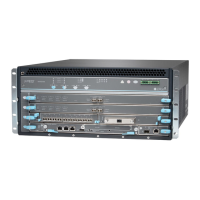•
Extractor clips—Used for inserting and extracting the Routing Engine.
•
Captive screws—Secures the Routing Engine in place.
The Routing Engine boots from the storage media in this order: the USB device (if present), then the internal
flash disk, then the hard disk, then the LAN.
NOTE: For specific information about Routing Engine components (for example, the amount of
DRAM), issue the show chassis routing-engine command.
Routing Engine for SRX5400, SRX5600, and SRX5800 Services GatewaysDescription
•
Junos OS Release 9.2 and later
•
Junos OS Release 10.0 and later required to install a second Routing Engine
Software release
AUX—Connects the Routing Engine to a laptop, a modem, or another auxiliary device through
a cable with an RJ-45 connector.
CONSOLE—Connects the Routing Engine to a system console through a cable with an RJ-45
connector.
ETHERNET—Connects the Routing Engine through an Ethernet connection to a management
LAN (or any other device that plugs into an Ethernet connection) for out-of-band management.
Cables and connectors
•
RESET button—Reboots the Routing Engine when pressed
•
ONLINE/OFFLINE Button—Not supported in the current release
Controls
Front panel slot in an SCB installed in:
•
SRX5400: Bottom slot 0
•
SRX5600: Bottom slots 0 or 1
•
SRX5800: Center slots 0 or 1
NOTE: The services gateway host subsystem Routing Engine must be installed in the SCB
in slot 0. A Routing Engine installed in an SCB in slot 1 only enables dual control links in
chassis cluster configurations.
Supported Slots
90 WPower Requirement
Approximately 2.4 lb (1.1 kg)Weight
79

